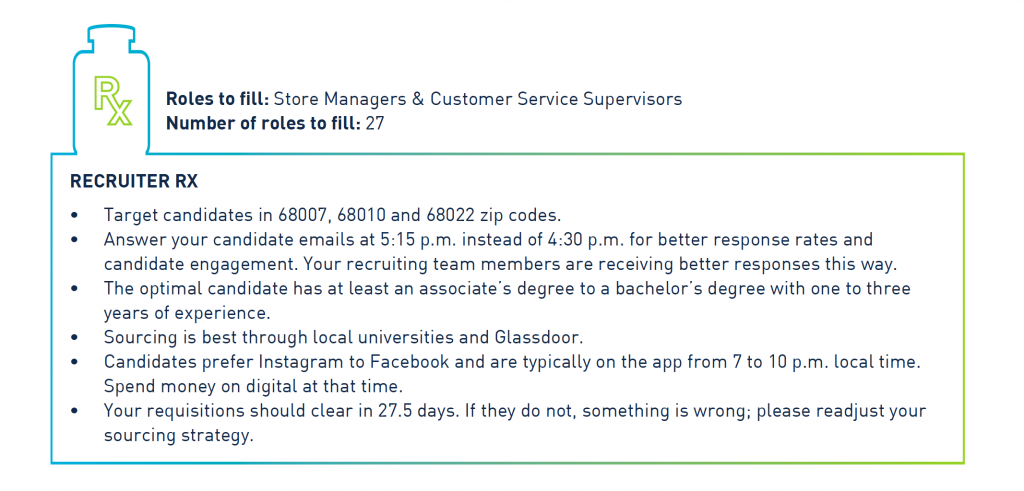Imagine your day as a lead recruiter for a major retailer. You have delivered successful results, but sometimes you get bogged down with small details. By the end of this month, you need to fill 27 requisitions for store managers and customer service supervisors – a pretty normal workload that you’re used to.
At 8 a.m., you look at a weekly dashboard report sent by your VP that describes how you are performing against monthly recruiting goals. You are doing well, but you have to turn it up a bit more. Ten of your requisitions are new, five are in the interview stage and eight are in the offer stage. You know how to manage this – you are a pro – but there is so much to do.
From 8:21 until 10:59 a.m., you respond to several calls, filter so many resumes you lose track, and perform a couple phone screens; it makes it hard to take a minute and plan with this type of pace.
By 3 p.m., the day has flown by and you now need to spend time reviewing your activity log for the day. In an ideal world, you’d clear your plate of your morning tasks and instead spend time building candidate relationships. However, you remind yourself that this type of pace and workload is true for most recruiters.
At 4:30 p.m., you receive some predictions from your finance team of where you need to shift your focus. This will help you manage your time better, but to be honest the data would have been more helpful if you had received it last month. You love reading the color-coded strike zone reports though and take note of how long it is taking to fill some of your harder-to-fill roles.
By 5:30 p.m., you leave feeling like you’ve done your best to tackle the day and made some real progress. You are putting out fires and making everything work, but what would be really helpful would be a prescription telling you what and where to attack each day to help you achieve even better results and be more efficient.
Maybe your prescription could look something like the following:

Prescriptive Analytics is Next
In our story, the recruiter received several different types of information, but the amount of disparate data was still unhelpful in the recruiter’s daily work. What our recruiter needed was some form of prescriptive analytics metrics to figure out where to focus their time.
What does prescriptive mean in the context of analytics? Prescriptive analytics solutions make predictions and answer questions related to “what to do” and why some action will take place. Prescriptive analytic output also delivers results from different options to help support various decision paths.
Prescriptive analytics solutions are only beginning to enter the mainstream world of talent acquisition. Rob Wells, managing director of Workday in Australia and New Zealand said, “The most innovative companies are relying on analytics in their HR programs and those that are implementing prescriptive analytics will reap the biggest rewards.” Gartner predicts that the prescriptive analytics software market will reach $1.1 billion by 2019. InformationWeek lists resource optimization, broadly termed as matching resources such as people and goods with an organization’s needs (e.g. talent acquisition), as a strong target for growth.
Prescriptive analytics is more easily understood in context with its relationship to descriptive and predictive analytics.
Predictive vs. Prescriptive Analytics
While predictive and prescriptive analytics sound alike, prescriptive analytics is the more advanced solution of the two. Prescriptive analytics builds on predictive analytics forecasts and transitional analytics solutions such as diagnostic analytics to evolve toward overall better decisions.
Predictive analytics today is more widely deployed. Predictive analytics uses data to find patterns and then uses that information to make forecasts that can shorten the recruiting process and produce stronger hires. While predictive solutions produce forecasts based on existing data, prescriptive solutions answer problems. As Gartner states, companies should ask “What can we do to make ____ happen” – prescriptive analytics helps answer that question.
Talent Analytics Adoption: Most, Some, Few
Descriptive Analytics
Receiving detailed data on past behavior equates to descriptive analytics. Most companies have this today.
Most organizations, up to 90 percent, are using some type of basic analytics function such as descriptive analytics. This is a common activity in talent acquisition as well. Descriptive analytics activities in talent acquisition looks at activity related to candidate generation, like the volume of candidates, time-to-close, cost of the candidate search and source-of-hire.
Predictive Analytics
Reviewing predictions of what might happen is predictive analytics. Some companies have this today.
Giant retailers such as Amazon are known for their predictive analytics solutions that manage data, inventory and customer needs. Some recruiters in talent acquisition have also begun to use predictive analytics tools. Predictive analytics throughout the sourcing process is also integrated into PeopleScout’s proprietary talent technology, Affinix.
Prescriptive Analytics
Knowing where to act and how to move in a specific way is prescriptive analytics. Few companies have this today.
The healthcare industry has seen success using prescriptive analytics. One company implemented a prescriptive analytics solution that analyzed the number of obese patients and then added cholesterol and diabetes risk levels to customize specific treatments. A few early possibilities are evolving for prescriptive analytics in talent acquisition. Prescriptive analytics could help predict learning paths for employees, helping to extend their tenure at an organization. Recruiters can also anticipate when candidates might ghost an opportunity – known as a candidate’s joining probability – and get a prescribed solution to fix the situation.
Challenges
As prescriptive analytics models enter the talent acquisition world, what are some implementation challenges to keep in mind?
- Price. Right now solutions are targeted and priced more for larger organizations.
- Talent. Many in-house analytics teams may not have enough people with the right skills to implement a prescriptive analytics solution. In fact many organizations are still struggling with adopting predictive.
- Buy-In. Organizational buy-in to implement a solution like prescriptive analytics is critical. Many organizations are still in the consideration stage for predictive analytics as mentioned and are not ready for prescriptive analytics offerings.
Preparing Your Prescription
How should you prepare for the use of prescriptive analytics? Regardless of your organization’s readiness for prescriptive analytics, you should keep the following planning tips in mind:
- Review your current analytics capabilities. Where is your organization in its analytics “journey?” Are you delivering complex or more simple descriptive analytics functions today?
- Evolve your analytics business case. What problems can you solve today, what would you like to solve in the future? What tools will help you meet different challenges?
- Assess potential vendors. Some vendors may say they are selling prescriptive analytics solutions but are not. Terminology across AI, machine learning and different analytics terms is sometimes misused. Do your due diligence to find out if your vendor can deliver the results you need.
Key Takeaways
- Prescriptive analytics is the most advanced stage of business analytics currently available after descriptive and predictive analytics solutions.
- While prescriptive analytics may not be used widely in talent acquisition, the potential for this next-generation analytics offering is promising.
- To prepare for prescriptive analytics implementation, assess your company’s existing analytics challenges and determine if prospective vendors are prepared to help you with the analytics problems you want to solve.

![[Webinar] Smart Hiring in the AI Age: What UK Candidates Are Really Doing in 2025](https://www.peoplescout.com/wp-content/uploads/2025/05/AI-enable-applicant-report-320x320.jpg)
